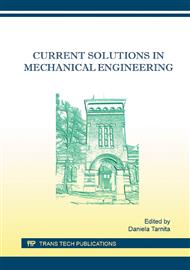[1]
J. A. Blaya, H. Herr, Control of a variable-impedance ankle-foot orthosis to assist drop-foot gait. IEEE Trans Neural Syst Rehabil Eng. 12(1) (2004) 24-31.
DOI: 10.1109/tnsre.2003.823266
Google Scholar
[2]
M. Ceccarelli, C. Copilusi, Dispositivo ad esoscheletro per asistenza alla locomozione umana. Camera di Commercio Industria Artigianato e Agricoltura, Provincia Frosinone, Italy. Patent FR2013A000013. (2013).
Google Scholar
[3]
C. Liang, M. Ceccarelli, Y. Takeda, Operation Analysis of a One-DOF Pantograph Leg Mechanisms. Proceedings of the RAAD '08. 17th International Workshop on Robotics in Alpe-Adria-Danube Region, Anncon,. Italy, (2008) 1–10.
DOI: 10.1109/raad.2010.5524538
Google Scholar
[4]
G. Carbone, M. Ceccarelli, Legged Robotic Systems, Cutting Edge Robotics ARS Scientific Book, Wien, (2005).
DOI: 10.5772/4669
Google Scholar
[5]
Contemplas Motion Analysis Equipment User manual. (2010).
Google Scholar
[6]
C. Copilusi, Researches regarding applicable mechanical systems in medicine. PhD. Thesis, (2009).
Google Scholar
[7]
K. Hirai, M. Hirose, Y. Haikawa, T. Takenaka, The development of Honda humanoid robot. Proceedings of IEEE International Conference Robotics and Automation, Leuven-Belgium, (1998) 1321–1326.
DOI: 10.1109/robot.1998.677288
Google Scholar
[8]
G. T. Huang, Wearable robots, Technology Review. (2004).
Google Scholar
[9]
H. Kawamoto, Y. Sankai, Power assist system HAL-3 for gait disorder person. Lecture Notes on Computer Science (LNCS). 2398. Berlin, Germany. (2002).
DOI: 10.1007/3-540-45491-8_43
Google Scholar
[10]
H. Kazerooni, R. Steger, The Berkeley lower extremity exoskeleton. Transactions of the ASME, Journal of Dynamic Systems, Measurements, and Control, 128 (2006) 14–25.
DOI: 10.1115/1.2168164
Google Scholar
[11]
J. Liu, M. Tan, X. G. Zhao, Legged robots – an overview, Transactions of the Institute of Measurement and Control. 29 (2) (2007) 185–202.
DOI: 10.1177/0142331207075610
Google Scholar
[12]
T. Li, M. Ceccarelli, An experimental characterization of a rickshaw prototype. Int. Journal of Mechanics and Control, 12 (4) (2012) 29–48.
Google Scholar
[13]
J. E. Pratt, B. T. Krup, C. J. Morse, S. H. Collins, The RoboKnee: An exoskeleton for enhancing strength and endurance during walking. Proc. IEEE International Conference on Robotics and Automation. New Orleans. USA. (2004) 2430–2435.
DOI: 10.1109/robot.2004.1307425
Google Scholar
[14]
G. A. Rodriguez, P. Rea, A new articulated leg for mobile robots. Industrial Robot: An International Journal. 38 (5) (2011) 521–532.
DOI: 10.1108/01439911111154090
Google Scholar
[15]
W. B. Shieh, L. W. Tsai, S. Azarm, Design and Optimization of a One-Degree-of-Freedom Six-Bar Leg Mechanism for a Walking Machine. Jnl of Robotic Systems. 14 (12) (1997) 871–880.
DOI: 10.1002/(sici)1097-4563(199712)14:12<871::aid-rob4>3.0.co;2-r
Google Scholar
[16]
C. Tavolieri, E. Ottaviano, M. Ceccarelli, Analysis and Design of a 1-DOF Leg for Walking Machines, Proceedings of RAAD'06, 15th International Workshop on Robotics in Alpe-Adria-Danube Region, Balantonfured, CD Proceedings. (2006). 63–71.
DOI: 10.1109/raad.2010.5524538
Google Scholar
[17]
D. Tarnita, D. N. Tarnita, M. Catana, Experimental measurement of flexion-extension movement in normal and osteoarthritic human knee, Romanian Journal of Morphology and embryology, 54 (2) (2013) 309–313.
DOI: 10.4028/www.scientific.net/amm.658.520
Google Scholar
[18]
D. Tarnita, M. Catana, D. N. Tarnita, Nonlinear Analysis of Normal Human Gait for Different Activities with Application to Bipedal Locomotion, Ro. J. Tech. Sci. Appl. Mech. 58 (1-2) (2013) 177–192.
Google Scholar
[19]
C. Walsh, K. Pasch, H. Herr, An autonomous, under-actuated exoskeleton for load-carrying augmentation. Proc. IEEE/RSJ International Conference on Intelligent Robots and Systems (IROS), Beijing, China, (2006) 1410–1415.
DOI: 10.1109/iros.2006.281932
Google Scholar
[20]
C. Walsh, K. Endo, H. Herr, A quasi-passive leg exoskeleton for load-carrying augmentation. Int. Journal H.R. 4(3) (2007) 487–506.
DOI: 10.1142/s0219843607001126
Google Scholar
[21]
M. Williams, Biomechanics of human motion, W.B. Saunders Co. Philadelphia and London. (1996).
Google Scholar


